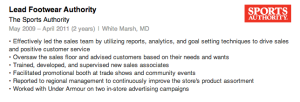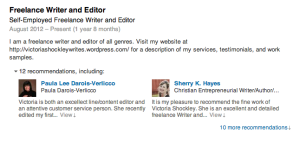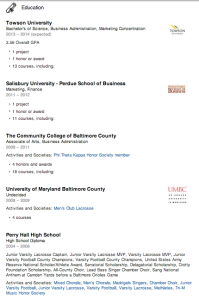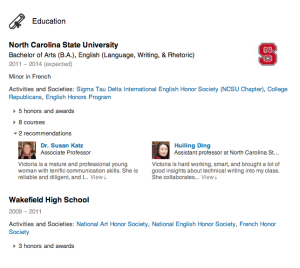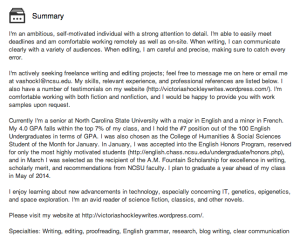 Have you stumbled upon this post as a student looking to finally figure out LinkedIn as you make the transition from college into your career? Perhaps your parents are on it or your professors have been urging you to join, but you just don’t get it. It’s not like Facebook — your friends aren’t all on it, and when you look at profiles created by people who have been out of school for years, you get overwhelmed by the amount of work experience they have listed.
Have you stumbled upon this post as a student looking to finally figure out LinkedIn as you make the transition from college into your career? Perhaps your parents are on it or your professors have been urging you to join, but you just don’t get it. It’s not like Facebook — your friends aren’t all on it, and when you look at profiles created by people who have been out of school for years, you get overwhelmed by the amount of work experience they have listed.
You’re not alone. I got my undergraduate degree less than five years ago, and I can still vividly remember my professors saying that, “as a graduating senior, LinkedIn is a must.” So, one afternoon I created an account, uploaded a picture, filled out a few sections, and added about 20 of my classmates and professors. After that … I did absolutely nothing.
LinkedIn for college students? I don’t get it
I didn’t really get the point of LinkedIn. Quite frankly, as a budding social media enthusiast I found the network to be, well, boring. It wasn’t until about a year or two later that I really started to see and understand the power that LinkedIn housed in vetting a position at any level and in growing personal networks.
As a college student, LinkedIn can be complex, confusing, and in my case, just plain uninteresting. Knowing this, I am never surprised to meet college students who either have created a profile but have no clue as to how to use the network, or who have no presence at all on the site. In fact, only 46 percent of millennials are aware that the network even exists. So, if you are reading this, I applaud you for being a part of the small percentage who are actually aware. I hope to clear some of the haze that surrounds LinkedIn by giving you a better understanding of who is currently on the platform, why LinkedIn for college students and recent grads should be a requirement, and how you can get started with LinkedIn yourself.
When it comes to membership on the LinkedIn network:
- LinkedIn states there are more than 30 million students and recent grads are on LinkedIn
- Thirteen percent of millennials are on LinkedIn
- More than 200,000 college students join LinkedIn every month
These stats show that although the population of college students and recent graduates may be appear small, it is actually larger than you probably had thought and it is growing. Now I know you’re wondering, “Well what’s the big deal?” Here is what we know:
- There are more than 2.9 million companies on LinkedIn, including executives from every Fortune 500 company
- Social professional networks are the fastest growing source of quality hires for global recruiters and are the No. 1 source for key quality hires for recruiters in the United States
- More than 97 percent of recruiters polled by Bullhorn used LinkedIn for recruiting in 2012 and 98.2 percent of recruiters use social media for recruiting
What does this show? It shows that recruiters and hiring managers are spending an immense amount of time on LinkedIn sourcing and finding talent on the network. Furthermore, Linkedin is constantly working with companies to post more entry level jobs and internships created specifically for college students and recent grads. So you see, LinkedIn can work for you to help you find your dream job (or at least the stepping stone job toward your dream job). If you invest a couple of minutes every day to stand out on LinkedIn, you will see the difference.
Getting started
Wondering where you start? Start by completing your profile on LinkedIn. With a complete profile, you are 40 times more likely to receive an new opportunity. A profile is considered complete if it has the following seven components:
-
An up-to-date current position with description
This can be an internship, retail position—whatever the case may be—add your current experience to your LinkedIn profile. Here are two examples of positions used by young professionals. One a retail position and the other, a creative way to position your portfolio or freelance work:
-
Two past positions
-
Add in your high school, fill out all your activities and awards, and add in any course work you have.
-
Three skills listed in the skills section
Think about your top skills in relation to the career you want. List those skills.
-
A PROFESSIONAL profile photo
-
At least 50 connections
-
Recommendations—these can be from an employer or a professor to offer credibility to your profile
Once you have the profile basics down you’re going to want to set yourself apart by making your profile a reflection of who you are as a person and how you’d like to grow professionally. Here is one example of a summary section that does just that. It reads as a professional narrative and reflects the writer’s story.
Intero’s own Colleen McKenna offers insight into how you can best create your professional narrative here. She also offers tips to personalize your LinkedIn Profile here.
Learning another social network may be the last thing on your to do list, especially one that isn’t the type of social media that you’re used to. However, I assure you, if you learn LinkedIn and use it strategically at beginning stages of your search, you will be successful in finding opportunity. All I ask is that when you land your first gig, you send me a note on LinkedIn letting me know about your success story.
Are you a professional reading this? Let students into your network. Find out why. What thoughts can you offer to students as the biggest challenge they will face starting out on LinkedIn and advice for how might they overcome it?
Let us know in the comments.

